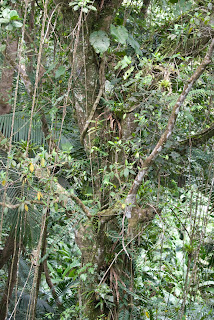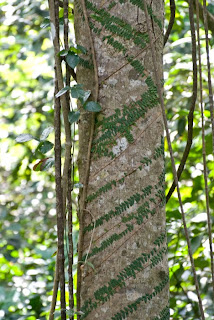St. Lucia Day Five: Rain Forest
Today we headed up into the heights of the northern mountains to explore a small part of the rain forest. It was impossibly hot and humid today and it was a blessing that for most of the morning it was slightly overcast. The drive to the Rainforest Sky Rides (you can also zipline down the mountain here) was a winding and slightly harrowing one as our shuttle driver negotiated 90 degree turns and unpaved mountain roads that had the added obstacles of dogs, goats and chickens.
There were only four of us in the gondola (they can hold eight) and up we went through the tops of the trees. The first part of the trip puts you right into the middle of the canopy and you are quickly surrounded by lush vegetation, plants on top of plants, trees indistinguishable from their surrounding vines and various hangers on. I learned something I never knew about vines and plants. I knew that the Coriolis Effect dictates the direction that hurricanes and tornadoes turn, and the direction water swirls in toilet bowls and drains in the Northern and Southern Hemispheres (counter-clockwise in the north and clockwise in the south). What I didn't know was that it also governs the direction by which vines twine around trees, thus the vines we saw clinging to the many trees we traveled past twined themselves counter-clockwise up trunks to the top of the canopy.
 The incredibly caustic Black Poisonwood Tree. This tree is related to Poison Sumac. Even rainwater dripping off of it can cause severe skin reactions. The wood is used to make musical instruments and furniture.
The incredibly caustic Black Poisonwood Tree. This tree is related to Poison Sumac. Even rainwater dripping off of it can cause severe skin reactions. The wood is used to make musical instruments and furniture. I've also never seen so many hummingbirds. They were everywhere. One even buzzed the gondola, giving us the hairy eyeball, and reminding us we were in its territory. We also got a good look at a St. Lucia Warbler. This warbler is endemic to St. Lucia and can be seen no where else. We also got a good look at broad-winged hawks circling the heights.
We learned many interesting things from our guide. To call someone an agouti in St. Lucia is to tell them they are forgetful. The agouti loves the fruit of the nutmeg tree and buries it much like a squirrel buries nuts. Obviously it doesn't remember where it buried every nutmeg fruit, thus it is considered a forgetful animal, but in doing so it provides a very beneficial service for the nutmeg tree, distributing its fruit and help the tree spread through out the forest.
 Tree Ferns. These look like something right out of the Jurassic Period. You kind of expect a T-rex to poke its head out from behind them.
Tree Ferns. These look like something right out of the Jurassic Period. You kind of expect a T-rex to poke its head out from behind them. Fiddlehead (fern frond) at the top of a Tree Fern. These are edible and taste like broccoli. They eat fiddleheads from regular ferns here in New England but if you ask me they taste like the bottom of a bog not broccoli.
Fiddlehead (fern frond) at the top of a Tree Fern. These are edible and taste like broccoli. They eat fiddleheads from regular ferns here in New England but if you ask me they taste like the bottom of a bog not broccoli.The St. Lucia forest is an oceanic rain forest. It is adapted to withstand hurricane force winds by having an open canopy. We got a very good look at this as the gondola turned and took us down the mountain and took us through the very tops of the trees.
After the gondola ride we went for a short hike through the forest. We nearly melted in the humidity, though it was nice to wander under the huge trees of the forest. We came across the fruit of the "Incense Tree", whose oils were used to create incense for churches. We got the oil all over our fingers and returned smelling like a religious ceremony.

When we returned to the the resort the sun came out in just the right way to turn the water Caribbean turquoise. The afternoon was spent floating around in it.

















Comments
Post a Comment
Let me know what you think.